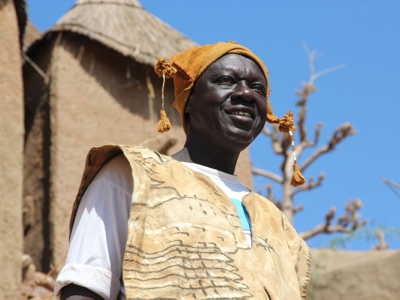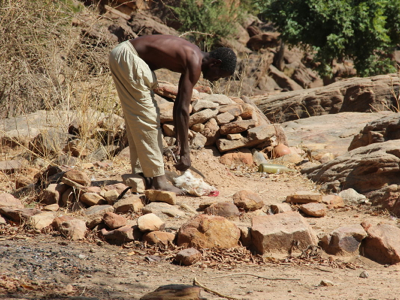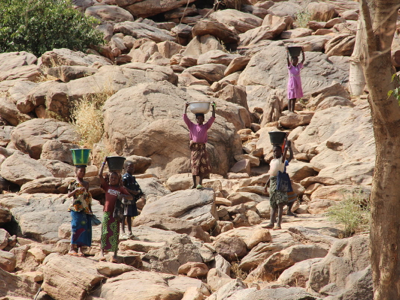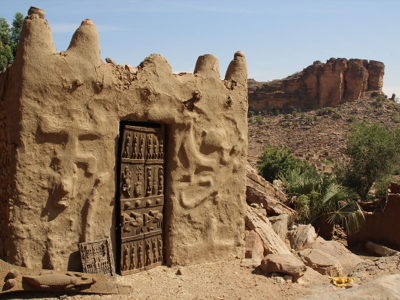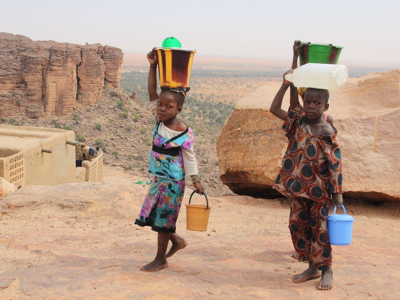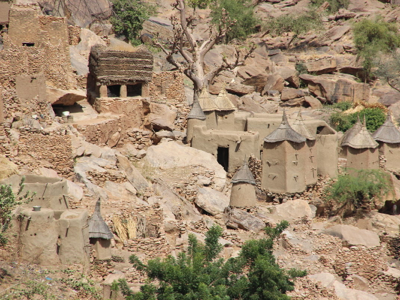From Houston to Sydney 2013

West Africa
2014
Our second day in Dogon Country was totally different to our first, but it was yet another magical experience.
After our third cold bracing shower in as many days to start the day, we enjoyed a relatively small breakfast at the hotel and then headed out with Mama and some local men to explore several Dogon villages.
Our explorations began in the village where we were staying (Sanga, also sometimes spelt Sangha), which is divided into two sections by the road that runs north-south through its centre. To the western (or upper) side is where the animists live, while the eastern (or lower) side is occupied by a mix of Muslims and Christians.
We began our walk through the animist section after receiving a strong warning that we must not deviate from the pathway shown by the local guide, as it would cause problems if we ventured onto land used for ceremonies or where fetishes were stored.
The warning was well taken, because one of our first stops on the walking tour was the large open area where ceremonies take place, with the low-roofed meeting shelter at one end, just behind the flat rock that is used for animal sacrifices and a beehive shaped dried mud cone where fetishes are stored.
We continued a circuitous route through the village, although little could be seen for much of the time because of the high walls that lined both sides of most of the narrow laneways. Several of the buildings and rocks were splashed with what looked like whitewash, but we were told this was where maize paste had been poured as type of sacrifice.
Our walk brought us to the opposite end of the ceremonial ground, and just off to one side of that was the house where the village’s ‘hogon’ lived. The ‘hogon’ is the oldest man in the village, and makes all the key decisions. He lives alone, and he never washes - it is believed that a snake comes to him each evening and licks him clean. In the small courtyard in front of his home is a small stone pot containing about twenty round river stones; each stone represents a former ‘hogon’, and a stone is added as each ‘hogon’ dies. The ‘hogon’ in Sanga is said to be about a hundred years old, and we had the privilege of meeting him today when he came out from his home to greet us. Considering his age, he looked quite robust, although he seemed to move in slow motion most of the time.
As we were walking over to the lower side of Sanga, we were welcomed into the home of a hunter. The exterior of his home was decorated by the skulls and other bones of various types of animals he had killed, and an interior room off his inner courtyard was even more lavishly decorated with bones (and I think quite a few pieces of cartilage too; they were a little difficult to identify). His interior room was filled with wooden Dogon masks and other wooden carvings that he had collected; dusty as they were, I think he was hoping I might offer to buy a piece or two. Clearly he doesn’t know about Australia’s quarantine regulations.
Going further into the lower side of Sanga, we came to the meeting house, low roofed like all the others but with an extraordinarily thick roof made up of thin pieces of timber that must have meant the area under the roof kept very cool, as several men were resting in the cool shade under the roof or in its nearby shadow.
More walking brought us to the onion gardens, verdant green and being tended laboriously by a large team of women carrying buckets of water on their heads from a well and pouring them loving over their onions. I could only think what a saving of labour could be made by installing some irrigation pipes, but of course, the balance of Mali’s resource endowment is people-rich and capital-poor. Pipes are expensive and wages are almost zero (especially for children), hence the intensity of the work we saw in the onion fields.
All too soon our walk around Sanga came to an end, and it was time to embark on our major task for the day, a trek from the top of the 300 metre (1,000 feet) high Bandiagara Escarpment down to the bottom, and back up again.
We needed to take a short drive to Bongo village to start the trek, and on the way, we stopped to see some fox diviners doing their work. Fox divining is not a common occupation in the west, but it is a Malian version of fortune telling. People who want answers to big questions regarding their future, such as job or relationships, consult a fox diviner and explain their problem. The fox diviner then goes out into a particular valley near Bongo and lays out a small rectangle of rocks, and within the rectangle he arranges some sticks and peanuts in a particular way that relate to the problem, together with some markings in the sand that look somewhat like a geometrical grid.
At night, the foxes come to eat the peanuts, and as they do so they move the sticks and leave their tracks in a certain way. Next morning, the fox diviner interprets the pattern left by the foxes, and delivers his message to the client. When we were passing this morning, several fox diviners were hard at work interpreting the patterns from the previous evening.
We got out of the car at Bongo in an area of onion farming – a hive of activity of watering and weeding, with other women nearby pounding millet. A short walk brought us to the edge at the top of the Bandiagara Escarpment, and a magnificent panorama unfolded before us. In some ways, the panorama at the foot of today’s diary (which was taken from that point) doesn’t do justice to the scene, because the scale of what lay before us was so immense. (Maybe if you click to enlarge the panorama you will get a better idea).
To our left, we could see the vertical cliff of the escarpment, and at its foot were some Dogon storehouses. Scanning towards our right, we could see the road that snakes its way down the escarpment and along the foot of the hills, past a succession of Dogon villages that follow the river at the foot of the escarpment. We could see several Dogon villages, but at first they seemed so well camouflaged that the houses looked just like the rocks around them; only on closer inspection could we see the distinctive shapes of the houses and their storage granaries.
Having taken in the magnificent vista, we walked back to the track from the onion gardens and found ourselves in front of a large cave that provided a passageway through to the other side of the ridge. At the entrance of the cave, a large group of children sang an enchanting if undecipherable welcome song – another great chance to make a short video on my phone, as the acoustics at the entrance of the cave were fabulous.
Emerging into the light at the other end of the cave, we saw a small mosque that marked the beginning of Gogoli village, another Dogon settlement. The layout of Gogoli was linear, lining the edge of the top of the escarpment. As we passed through, a resident with excellent English (apparently a former guide) invited us into the courtyard of his home to show us his carved door and window, both of which made him justly proud. Carved doors and windows, with their wooden locks, are a feature of traditional mud brick Dogon homes, and he was keen to help us understand the significance of the fairly standard arrangement of figures carved into them.
The narrow track that descended down the escarpment began at the southern end of Gogoli. After taking in some last views of the village below (called Banani, our destination), we began the descent. Mama had heard that I had a hip replacement three months ago, and he asked a young man from Gogoli to accompany me and hold my hand to steady me on the rough sections of the track. It was a lovely but unnecessary gesture; he kept calling me “papa” as he helped me and held my hand high to help me keep steady. After the trek, mama confided to me that he had ‘tested’ me at the circumcision grotto at Songho yesterday – how I handled the climb to the top of the peak was my ‘test’ of whether we would be doing the trek today. Apparently I passed with flying colours – but he still thought I should be accompanied by the young man from Gogoli just in case.
The track was steep and quite rough in places, although surprisingly well formed with rocks stabilized by concrete on one especially steep section. The stabilization was done by local people, as the track we were using was the primary ‘highway’ for Dogon people to travel between the top and the bottom of the escarpment.
As we descended, I just had to keep stopping to get photographs as the vistas opened up and the details of Banani village became clearer. In several places, we could clearly see the cliff-side dwellings that the Tellem people had used before the Dani came in the 12th and 13th centuries. (Interestingly, the Tellem people were not the first to occupy this area; they in turn displaced pygmy people when they migrated into the area).
As we descended and entered Banani, one of the first buildings we encountered was the thick-roofed, low-ceilinged meeting house. Several men seemed to be enjoying the shade as we walked past – perhaps the fact that women are banned from the area helped them to relax?
It was obvious in both Gogoli and Banani (as well as in larger centres such as Sanga, of course) that some of the traditional ways of life are starting to change. Some of the houses are now being built with stones rather than the traditional mud brick, and a few houses even had a motor cycle parked beside them. And yet the old traditions still run deep. As we walked along one pathway, we came upon a man sacrificing a chicken on sacred ground used for fetish worship. Apparently he believed another man had lied to him, and by slitting the throat of the chicken (after seeming to put it through quite a bit of agony before hand), he believed that the ‘liar’ would be cursed and would die. He sincerely believed this would happen, although I have no idea what time limit he thought would apply to his curse. The dead chicken was left on the fetish altar, and we were told that “no-one, not even dogs, could touch the meat”.
We spent some more time roaming around the village, especially in the cool, shady area along the small river, and we even found a small hotel where I shouted our guides and helpers to a cool drink. As we neared the end of our walk, I had a whispered conversation with Mama:
Me: “How much do you think I should pay the young man who has helped me on the walk?”
Mama: “You should not pay him anything. He has done this as a gift to you.”
Me: “But I feel I should give him something small to express my appreciation for his care.”
Mama: “Yes, that would be a very good thing to do.”
Me: “So how much do you think would be appropriate?”
Mama: “It’s up to you. After all, it is a gift to you.”
Me: “Do you think 500 CFAs would be about right?” (about $1).
Mama: “No, I think 500 CFAs is not enough. I think 1000 CFAs would be about right”.
Me: “Oh, okay. 1000 CFAs it is then!”
We returned to our hotel at Sanga for a late lunch at about 1:30 pm. As always, the menu was set and the food was simple but very tasty and generous. Today’s lunch was beef in a smoky sauce with couscous, with a bowl of minestrone soup for Andrew and I share by pouring it over the couscous. This was followed by a dessert of two small bananas each.
With some regret, we left Sanga at 2:30 pm and headed south-west on the very rough back to Bandiagara. Although the distance from Sanga to Bandiagara is only 45 kilometres, the journey took an hour and a half, and after the rough, dusty trip, it was quite a joy to arrive at our hotel in Bandiagara, the Hôtel La Falaise.
Like the hotel at Sanga, La Falaise has simple rooms with two low beds topped with mosquito nets, and a simple bathroom with (promised!) hot water. Like the places we have stayed for the previous few nights, this hotel provides towels and soap, but no shampoo. And like the hotel in Sanga, the simplicity of the rooms is complemented beautifully by having a lovely, shady garden area where Andrew and I were able to relax over a cool drink – this time with internet –sadly though, the slowest I have seen anywhere for many years.

Day 13 - Dogon Country, Mali
Thursday
9 January 2014





































